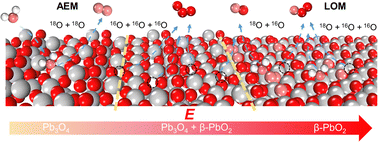Phase shuttling-enhanced electrochemical ozone production†
Abstract
Ozone can be produced by the electrochemical oxidation of water, which provides a technical solution to on-demand ozone production for disinfection and sterilization. Lead oxides have been found to be unique in catalyzing such a process. However, the fundamental understanding of these catalysts’ mechanisms remains limited, hindering the development of high-performance catalysts for electrochemical ozone production (EOP). Herein, the effect of phase shuttling on the reactivity of Pb3O4 was systematically investigated during the EOP process by in situ/ex situ characterizations. It was found that Pb3O4 undergoes a phase shuttle towards β-PbO2via the lattice oxygen oxidation mechanism (LOM) pathway, and the reconstructed β-PbO2 shows enhanced EOP activity and stability compared to commercial β-PbO2. The ex situ characterization of materials combined with theoretical calculations reveals that the performance enhancement is mainly attributed to the stable presence of (101) and (110) surfaces in the reconstructed β-PbO2 with undercoordinated Pb–O. Pourbaix diagrams of lead oxides calculated by DFT demonstrate that the phase shuttling to β-PbO2 is thermodynamically favorable under EOP conditions. Surface Pourbaix diagrams of β-PbO2(101) and Pb3O4(110) further reveal the adsorption behavior of O*/OH* intermediates and explain the observed change of EOP kinetics at ∼1.6 V vs. RHE. The catalyst is integrated and assembled in a membrane electrode assembly (MEA) electrolyzer, and the produced ozonated water successfully inactivated severe acute respiratory syndrome coronavirus 2 (SARS-CoV-2). This work provides a new insight into EOP catalysts and demonstrates the possibilities of further optimization of electrochemical approaches for on-demand ozone generation.

- This article is part of the themed collections: The EES Family Board Members Collection and Spotlight on Women in Energy


 Please wait while we load your content...
Please wait while we load your content...